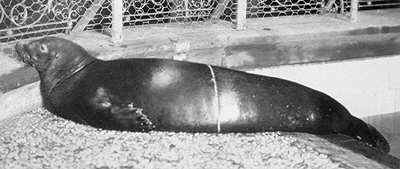Caribbean Monk Seal (Monachus tropicalis) - Wiki Caribbean Monk Seal
From Wikipedia, the free encyclopedia
Order: Carnivora
Suborder: Pinnipedia
Family: Phocidae
Status: Extinct (mid-1950s)
[Photo] Captive Caribbean monk seal, Monachus tropicalis, of unknown sex at the New York Aquarium in ca. 1910. Specimen originally captured from either Arrecife´s Tria´ngulos (Campeche) or Arrecife Alacra´n (Yucatan) in Mexico (Townsend 1909). Source: The Extinction Website (www.petermaas.nl/extinct/). Date 1910. Author: New York Zoological Society.
The Caribbean Monk Seal or West Indian Monk Seal (Monachus tropicalis), the only seal ever known to be native to the Caribbean sea and the Gulf of Mexico, is now considered extinct. In the United States, the last recorded sighting of this marine mammal occurred in 1932 off the Texas coast. The very last reliable records of this species are of a small colony at Seranilla Bank, Jamaica, in 1952.
The Caribbean Monk Seal was a relatively small seal (6-9 feet) with rolls of fat around its neck and brown pelage that faded to a yellow-white color on the stomach. The soles and palms were naked, with the nails on the anterior digits well developed. The males reached a length of about 2.25 meters and weighed up to 200 kilograms. Displaying sexual dimorphism, the females of this species were generally smaller than males.
These pinnipeds lived in marine environment, spending much of their time in the water and occupying rocky and sandy coastlines for shelter and breeding. Their diet included eels, lobsters, octopus, and other reef fish.
Like other true seals, the Caribbean Monk Seal was sluggish on land. Its lack of fear for man and an unaggressive and curious nature also contributed to its demise.
A collection of Caribbean Monk Seal bones can be found at the Tropical Crane Point Hammock Museum in Key Vaca.
Reproduction and longevity
Very little is known about the reproduction behavior and longevity of this animal. Live pups were likely born in early December because several females killed in the Yucatan during this time of the year had well-developed fetuses. It is believed that this animal's average lifespan was approximately 20 years.
http://en.wikipedia.org/wiki/Caribbean_Monk_Seal
| The text in this page is based on the copyrighted Wikipedia article shown in above URL. It is used under the GNU Free Documentation License. You may redistribute it, verbatim or modified, providing that you comply with the terms of the GFDL. |
